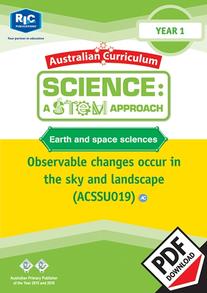Science: A STEM approach – Year 1 ebook
Preview Book
- Format: Ebooks
- Series: Australian Curriculum
- Code: RIC-3715 | ISBN-9781925812558
- Subject: STEM
- Level: Year 1
Price:
$47.95
Quantity:
Prepare your students for the roles of the future! Minds will be challenged and imaginations unleashed as students develop skills such as innovation, creativity, reasoning and problem-solving; and technical science skills such as questioning, observing, systematic experimentation, and analysis and interpretation of data.
Feel confident delivering a comprehensive and contemporary science program, and ease your way into STEM projects with Science: A STEM approach Year 1 for ages 5—6.
Each book in this fantastic series features:
- four units with four STEM projects, organised by sub-strand—Biological sciences, Chemical sciences, Earth and space sciences and Physical sciences
- easy-to-follow lesson plan format, with term overview at the start of each unit
- ideas for incorporating technology in the classroom
- background information for the teacher
- resource sheets, if required
- assessment sheets provided for science knowledge
- STEM project for the remainder of the term (2–4 weeks)
Each STEM project includes:
- a design brief
- STEM curriculum links
- alternative project ideas
- a group rubric
- self-assessment
- resource sheets, if required
Science Understanding
- Living things have a variety of external features (ACSSU017)

- Living things live in different places where their needs are met (ACSSU211)

- Everyday materials can be physically changes in a variety of ways (ACSSU018)

- Observable changes occur in the sky and landscape (ACSSU019)

- Light and sound are produced by a range of sources and can be sensed (ACSSU020)

Science as a Human Endeavour
- Science involves observing, asking questions about, and describing changes in, objects and events (ACSHE021)

- People use science in their daily lives, including when caring for their environment and living things (ACSHE022)

Science Inquiry Skills
- Pose and respond to questions about familiar objects and events (ACSIS024)

- Participate in guided investigations to explore and answer questions (ACSIS025)

- Use informal measurements to collect and records observations, using digital technologies as appropriate (ACSIS026)

- Use a range of methods to sort information, including drawings and provided tables through discussion, compare observations with predictions (ACSIS027)

- Compare observations with those of others (ACSIS213)

- Represent and communicate observations and ideas in a variety of ways (ACSIS029)

To enhance your experience in using this series, all supporting online materials have been collated within one online resources page - which can be found here. This page is continuously updated by our editors with new and exciting activities! Please inform us if you find a broken link and we work on fixing this issue.
**This ebook is not transferable, nor can it be on-sold or uploaded to an intranet site. For full copyright details, please see the Copyright Notice outlined in the ebook or refer to the Copyright Agency Limited www.copyright.com.au
No reviews have been added for this product yet.












